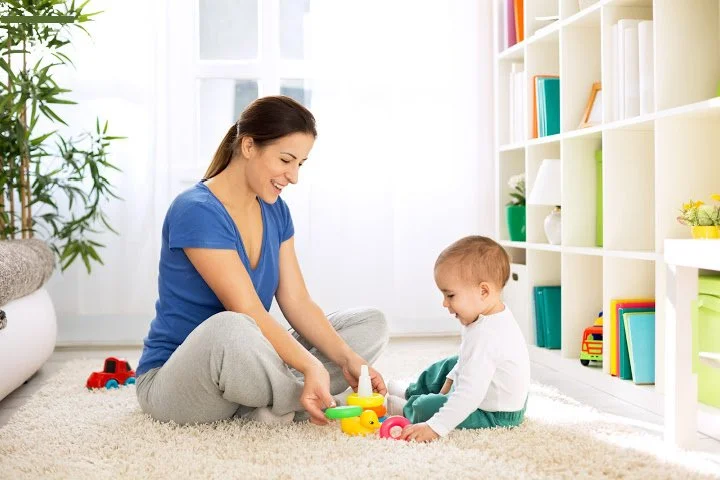Attachment Theory
Sir John Bowlby, a renowned British psychologist, with the help of other brilliant child development scholars, founded Attachment Theory, which categorizes and predicts the impact of early parent-child relationships on later development. Attachment theory posits that infants have an innate need to form an emotionally intimate relationship with a caregiver for their own survival and to achieve optimal psychosocial development. If this innate need for a warm and continuous relationship is not satisfied by primary caregivers, children will likely experience difficulties in their emotional and social development. To more fully understand the impact of attachment relationships on child development, Bowlby and his colleague, the eminent Mary Ainsworth, designed a standardized study called the “Strange Situation” that analyzed how infants reacted to separation from their caregivers and categorized infant behavior upon reunion with their returning caregiver. If you wish to gain a better understanding of this fascinating study, check out the video below.
This video shows an excerpt from the “Strange Situation” study developed by Mary Ainsworth to observe and categorize attachment behavior and emotional security in infant-caregivers relationships. The infant’s reaction to separation and reunion is carefully monitored.
Findings from the “Strange Situation” studies suggest that infants will react in one of four ways in response to separation from—and reunion with—their caregivers. Infant reaction is correlated with the quality of caregiving the caregiver has provided the infant since birth, and is largely dependent upon the caregiver’s own “attachment style” which is a byproduct of the quality of the caregivers relationships with her own parents or caregivers.
Here are the four “attachment styles” that Ainsworth and her colleagues found to be most common in infants in response to separation and reunion with their caregivers. These early attachment styles tend to predict how closeness will be handled in adult relationships.
Secure attachment: infants show distress when their caregivers leave but are easily comforted upon reunion.
Anxious-resistant attachment: infants experience even greater levels of distress when their caregivers leave and try to “punish” the caregivers while at the same time seeking comfort upon reunion.
Avoidant attachment: infants display either no distress or minimal distress when their caregivers leave the room and refuse caregiver comfort upon reunion by withdrawing and ignoring the returning caregiver.
Disorganized-disoriented attachment: infants have no predictable pattern of attachment behaviors when they are in this type of situation. Their behavior upon reunion can appear disorganized, fearful, or normal (even if the infant is distressed on the inside).
A child’s attachment style is largely reflective of the care the child received from the primary caregiver in infancy and early childhood. Children will likely develop a “secure attachment” if they receive consistent support and positive emotional attention from their caregivers as well as protection from harm. Conversely, children will most likely experience emotional and relational difficulties if they are neglected or receive inconsistent care and attention from their primary caregivers. Children must be given the opportunity to form a warm and stable emotionally significant relationship with at least one of their caregivers to promote healthy psychological and social development.
”Secure attachment” usually develops when a caregiver creates a “secure base” for their children which includes curiousity about the needs and feelings of the child and consistent efforts to nurture, support, empower and protect their children from harm. In a secure relationship, the child knows he can return to the caregiver for soothing and direction. The child can then internalize this secure relationship and use it as a model for building his own relationship with himself allowing him to develop an interest in his own feelings and the skills to self-soothe when in distress and protect himself from harm.
What does this mean for future relationships?
How we conduct ourselves in adult relationships, particularly romantic or other types of intimate relationships, is directly related to the quality of care we received from our parents or primary caregivers. The attachment styles that emerge in childhood are likely to show up in our adult relationships. Here are some typical patterns:
Secure attachment: individuals are more likely to feel satisfied and secure in their relationships. They also feel close to their partners without having to be together all the time. These types of relationships tend to show high degrees of honesty, support, trust, and emotional connection while being resilient enough to endure separation without unraveling.
Dismissive-Avoidant attachment: Adults with this attachment style often try to keep their distance from others. They usually prefer to isolate from others and prioritize their independence because they have been wired to behave as though they do not need relationships to survive. In actuality, they have not been able to count on relationships being safe or “secure,” so avoidance of committed relationships becomes a coping strategy to ward off feelings of fear and anger and grief associated with their earliest abandonments.
Anxious-Preoccupied attachment: These adults tend to form bonds with little relationship security so they often demonstrate a desperation for, and a preoccupation with, love and attention. They rely on their partners to “complete” them in order to try to make up for the insecurity they feel inside. Although they crave love and attention, these individuals may behave in self-defeating ways that actually push their partners away. For example, “anxious-preoccupied” individuals can show signs of jealousy, assert unrelenting demands on their partners, or get easily angered by relatively insignificant things. These adults are also often reacting in the present to unresolved pain and anger from their earliest relationship failures with their caregivers.
Fearful-Avoidant aka Ambivalent attachment: This attachment style is closely linked to dismissive-avoidant attachment. However, instead of showing preferences for isolation, these adults show ambivalence in their relationships. They tend to avoid feeling or expressing their feelings at all costs because they can get easily overwhelmed or emotionally “flooded.” Ambivalently attached adults can act in unpredictable ways and have frequent mood swings in response to the insecurity that exists, or that they create, in their adult relationships. These adults are also often bringing into (and projecting onto) their adult relationships the unresolved pain and anger from their earliest relationship failures with their caregivers. However, in their minds, their behavior toward their current partner is usually fully justified and unrelated to their early relationships with their caregivers.
The insecure attachment styles, if not addressed and corrected through psychotherapy or coaching, usually interfere with the formation of healthy, emotionally intimate relationships.
Adult attachment styles are used to describe and understand how individuals may behave in different relationships rather than describing exact personality types. The attachment style of one adult can be greatly affected and influenced by interactions with another person who has a different attachment style. There is a great deal of variety in attachment behaviors. It is important to seek out effective psychotherapy if there are high levels of conflict in your relationships or if you believe your attachment style and inherited and learned relationship habits are interfering with your ability to find or sustain healthy intimate relationships with friends or romantic partners. Your attachment style can be changed (upgraded) by working with an experienced psychologist who is has expertise in healing attachment trauma.








